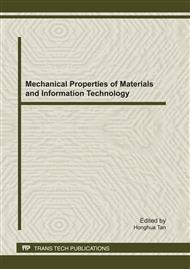[1]
R. B. Singh and D. Downing, Antioxidants and coronary artery disease, Journal of Nutritional and Environmental Medicine, vol. 5, pp.219-224, (1995).
DOI: 10.3109/13590849509000222
Google Scholar
[2]
A. M. Botterweck, H. Verhagen, and R. A. Goldbohm et al., Intake of butylated hydroxyanisole and butylated hydroxytoluene and stomach cancer risk: results from analyses in the Netherlands cohort study, Food and Chemical Toxicology, vol. 38, pp.599-605, (2000).
DOI: 10.1016/s0278-6915(00)00042-9
Google Scholar
[3]
J.P. Yu, and L.Q. Gu, The chemical constituents of laoying tea from Guizhou, Journal of Plant Resources and Environment, vol. 10, pp.61-62, (2001).
Google Scholar
[4]
J.Q. Wang, J. Li, and Y.H. Zou et al., Preventive effects of total flavonoids of Litsea coreana leve on hepatic steatosis in rats fed with high fat diet, Journal of Ethnopharmacology, vol. 121, pp.54-60, (2009).
DOI: 10.1016/j.jep.2008.09.029
Google Scholar
[5]
J.H. Liu, Effect of glede tea to blood sugar and blood fat of rats, Chinese Journal of the Practical Chinese Modem Medicine, vol. 3, pp.2057-2057, (2003).
Google Scholar
[6]
T. Sun and C. Ho, Antioxidant activities of buckwheat extracts, Food Chemistry, vol. 90, no. 4, pp.743-749, (2005).
DOI: 10.1016/j.foodchem.2004.04.035
Google Scholar
[7]
M. Oyaizu, Studies on products of browning reactions: antioxidative activities of products of browning reaction prepared from glucosamine, Japanese Journal of Nutrition, vol. 44, pp.307-315, (1986).
DOI: 10.5264/eiyogakuzashi.44.307
Google Scholar
[8]
T.C.P. Dinis, V.M.C. Madeira, and L.M. Almeida, Action of phenolic derivatives (acetaminophen, salicylate, and 5-aminosalicylate) as inhibitors of membrane lipid-peroxidation and as peroxyl radical scavengers, Archives of Biochemistry and Biophysics, vol. 315, pp.161-169, (1994).
DOI: 10.1006/abbi.1994.1485
Google Scholar
[9]
D.A. Gray, M.J. Clarke, and C. Baux et al., Antioxidant activity of oat extracts added to human LDL particles and in free radical trapping assays, Journal of Cereal Science, vol. 36, pp.209-218, (2002).
DOI: 10.1006/jcrs.2001.0456
Google Scholar
[10]
W. C. Hou, R. D. Lin, and T. H. Lee et al., The phenolic constituents and free radical scavenging activities of Gynura formosana kiamnra, Journal of the Science of Food and Agriculture, vol. 85, pp.615-621, (2005).
DOI: 10.1002/jsfa.2017
Google Scholar
[11]
Sanchez-Moreno, Methods used to evaluate the free radical scavenging activity in foods and biological systems, Food Science and Technology International, vol. 8, pp.121-137, (2002).
DOI: 10.1177/1082013202008003770
Google Scholar
[12]
V. López, S. Akerreta, and E. Casanova et al., In-vitro antioxidants and anti-rhizopus activity of Lamiaceae herbal extracts, Plant Foods for Human Nutrition, vol. 62, pp.151-155, (2007).
DOI: 10.1007/s11130-007-0056-6
Google Scholar
[13]
M.H. Gordon, The mechanism of antioxidant action in vitro. In: Hudson BJF (ed) Food Antioxidants, London: Elsevier Science, pp.1-18, (1990).
Google Scholar
[14]
Y.L. Lee, M.T. Yen, and J.L. Mau, Antioxidant properties of various extracts from Hypsizigus marmoreus, Food Chemistry, vol. 104, pp.1-9, (2007).
DOI: 10.1016/j.foodchem.2006.10.063
Google Scholar
[15]
G.C. Yen and D.Y. Chung, Antioxidant effects of extracts from Cassia tora L. prepared under different degrees of roasting on the oxidative damage to biomolecules, Journal of Agricultural and Food Chemistry, vol. 47, pp.1326-1332, (1999).
DOI: 10.1021/jf9810618
Google Scholar
[16]
M. Wettasinghe and F. Shahidi, Iron (II) chelation activity of extracts of borage and evening primrose meals, Food Research International, vol. 35, pp.65-71, (2002).
DOI: 10.1016/s0963-9969(01)00120-x
Google Scholar


